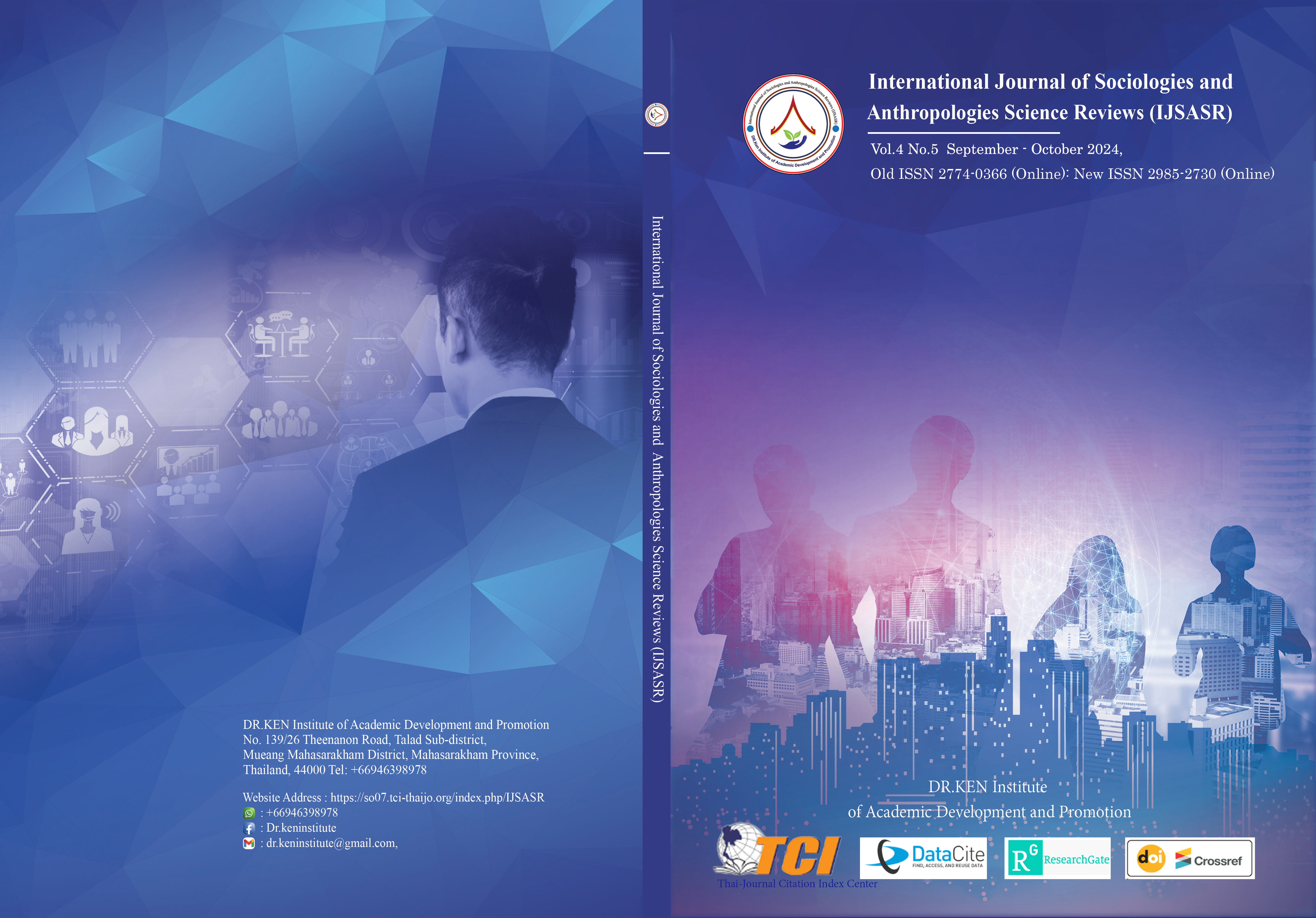Musical Structures of Weifang Folk Songs: A Study in Contemporary Social Contexts
Main Article Content
Abstract
Background and Aims: This study delves into the musical structure of Weifang Chinese folk songs within their contemporary social context, aiming to investigate the musical structure of Weifang Chinese folk songs in their current social context.
Materials and Methods: A comprehensive methodology integrating ethnographic fieldwork, archival research, interviews, and musical analysis was employed. Fieldwork in the Weifang region involved observing folk song performances, interacting with local musicians, and documenting cultural practices. Archival research examined historical materials, while interviews gathered insights from folk musicians, community members, and cultural experts. Musical analysis and transcription techniques were applied to understand the intricate musical structures of Weifang folk songs.
Results: The study revealed the diverse genres, expressive themes, and unique musical structures of Weifang folk songs, including the two-sentence, three-sentence, four-sentence, and multisentence patterns. The songs exhibited rich cultural tapestries, reflecting local customs, language traditions, and communal sentiments.
Conclusion: Weifang folk songs have evolved to adapt to changing social dynamics, serving functions ranging from labor encouragement to educational inheritance and entertainment. The study underscores the significance of cultural heritage preservation programs and interdisciplinary collaborations to safeguard and promote Weifang's musical legacy.
Article Details

This work is licensed under a Creative Commons Attribution-NonCommercial-NoDerivatives 4.0 International License.
Copyright on any article in the International Journal of Sociologies and Anthropologies Science Reviews is retained by the author(s) under the under the Creative Commons Attribution-NonCommercial-NoDerivatives 4.0 International License. Permission to use text, content, images, etc. of publication. Any user to read, download, copy, distribute, print, search, or link to the full texts of articles, crawl them for indexing, pass them as data to software, or use them for any other lawful purpose. But do not use it for commercial use or with the intent to benefit any business.

References
Abebe, T. (2021). Storytelling through popular music: Social memory, reconciliation, and intergenerational healing in Oromia/Ethiopia. Humanities, 10(2), 70. https://doi.org/10.3390/h10020070
Appadurai, A. (1996). Modernity at large: Cultural dimensions of globalization. University of Minnesota Press.
Becker, H.S. (1982). Art worlds. University of California Press.
Bhabha, H.K. (1994). The location of culture. Routledge.
Blacking, J. (1973). How musical is man? University of Washington Press.
Cantillon, Z., Baker, S., & Chalk, L. (2023). Leveraging popular music heritage as sustainable cultural infrastructure in small cities. International Journal of Cultural Policy, 29(6), 716-732. https://doi.org/10.1080/10286632.2022.2138365
Chen, H., & Sensai, P. (2024). Education and Literacy in the Development and Transmission of Chinese Yao Nationality Folk Songs. International Journal of Education and Literacy Studies, 12(1), 213-220. https://doi.org/10.7575/aiac.ijels.v.12n.1p.213
DeNora, T. (2000). Music in everyday life. Cambridge University Press. https://doi.org/10.1017/CBO9780511489433
Giray, L. (2022). Meet the Centennials: Understanding the Generation Z students. International Journal of Sociologies and Anthropologies Science Reviews, 2(4), 9-18.
Ho, W.C. (2018). Culture, music education, and the Chinese dream in Mainland China (Vol. 7). Singapore: Springer. https://doi.org/10.1007/978-981-10-7533-9
Ho, W.C., & Ho, W.C. (2018). The rise of individualistic values, social change, popular culture, and depoliticization: challenge to music education. Culture, Music Education, and the Chinese Dream in Mainland China, 155-193. https://doi.org/10.1007/978-981-10-7533-9_6
Howard, K. (Ed.). (2016). Music as intangible cultural heritage: Policy, ideology, and practice in the preservation of East Asian traditions. Routledge. https://doi.org/10.4324/9781315596723
Huang, Y. (2024). Cultural Harmonies: Exploring Compositional Techniques and Cultural Fusion in Guizhou Ethnic Minority Music. Pacific International Journal, 7(1), 216-221. https://doi.org/10.55014/pij.v7i1.558
Kim, J.A. (2015). Cultural transfer as a branch of research for music sociology and music anthropology. International Review of the Aesthetics and Sociology of Music, 46 (1),43-53.
Lan, Y. (2023). Bamboo-branch Songs (zhuzhici) of Shandong Province: Lyrical Records of Local Life, Traveling and Local History. Bayerische Julius-Maximilians-Universitaet Wuerzburg (Germany).
Li, J., Onlamul, K., You, L., & Yang, F. (2024). Transmission Guidelines for Literacy Studies in Si Zhu Yue Traditional Chinese Folk Music. International Journal of Education and Literacy Studies, 12(2), 80-86.
Li, Z. (2021). Influences of Chinese Cultural Traditions on Piano Music by Chinese Composers: Analytical Study of Representative Piano Works Through 1980, With Pedagogical and Performance Considerations. Doctoral dissertation: University of Northern Colorado.
Liu, Q., & Chonpairot, J. (2024). Exploring the Narrative and Aesthetic Aspects of Huanglong Opera in Nong'an County Jilin Province China. International Journal of Sociologies and Anthropologies Science Reviews, 4(2), 279-288. https://doi.org/10.60027/ijsasr.2024.3930
Lomax, A. (2017). Folk song style and culture. Routledge. https://doi.org/10.4324/9780203791844
Merriam, A. P. (1964). The anthropology of music. Northwestern University Press.
Nettl, B. (1983). The study of ethnomusicology: Thirty-three discussions. University of Illinois Press.
Pearce, M.T. (2018). Statistical learning and probabilistic prediction in music cognition: mechanisms of stylistic enculturation. Annals of the New York Academy of Sciences, 1423(1), 378-395. https://doi.org/10.1111/nyas.13654
Song, X., Cheong, K.C., Wang, Q., & Li, Y. (2020). Developmental sustainability through heritage preservation: two Chinese case studies. Sustainability, 12(9), 3705. https://doi.org/10.3390/su12093705
Tang, K. (2021). Singing a Chinese nation: Heritage preservation, the Yuanshengtai movement, and new trends in Chinese folk music in the twenty-first century. Ethnomusicology, 65(1), 1-31. https://doi.org/10.5406/ethnomusicology.65.1.0001
Trehub, S. E., Becker, J., & Morley, I. (2015). Cross-cultural perspectives on music and musicality. Philosophical Transactions of the Royal Society B: Biological Sciences, 370(1664), 20140096. https://doi.org/10.1098/rstb.2014.0096
Yang, Y., & Welch, G. (2016). Pedagogical challenges in folk music teaching in higher education: a case study of Hua'er music in China. British Journal of Music Education, 33(1), 61-79. https://doi.org/10.1017/S0265051715000248
Yao, L., & Chaotchamrat, S. (2023). Cultural Education and Instruction of Chinese Meizhou Hakka Mountain Songs in Guangdong: Education and Instruction of Chinese Meizhou Hakka Mountain Songs. International Journal of Curriculum and Instruction, 15(3), 2193-2205.
Yao, L., Sensai, P., & Junkate, K. (2023). Nurturing cultural engagement and learning among youth through Jingyun Dagu traditional Chinese folk songs in Tianjin Municipality: Cultural engagement and learning among youth. International Journal of Curriculum and Instruction, 15(3), 1845-1859.






